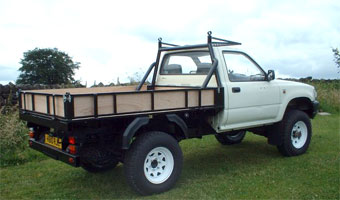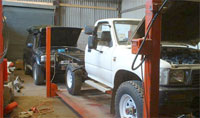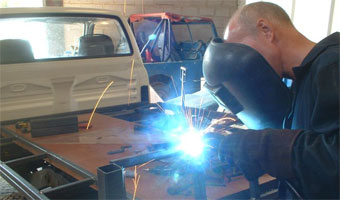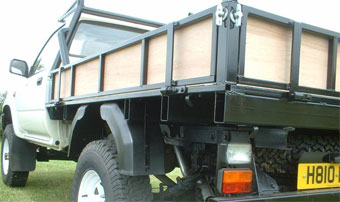'Desert Ute' ~ A pickup for the Sahara
in association with the Matt Savage Ute
Institute (MSUI)

Stage One
 The
production line (right) at Matt's Institute has been humming
along like the Mayfly AGM after a few too many pollen lagers.
Matt's kids have grown up, left home and got jobs while he's
locked himself in his Operations Barn The
production line (right) at Matt's Institute has been humming
along like the Mayfly AGM after a few too many pollen lagers.
Matt's kids have grown up, left home and got jobs while he's
locked himself in his Operations Barn  of
weeks. The results are on the left: the Desert
Ute is on the road. of
weeks. The results are on the left: the Desert
Ute is on the road.
To be honest I don't know what's
come over him. I sneak up out of a drain for a surprise inspection
at 4am and find him and Barry drilling, grinding and hammering
away like two ferrets in a steel mill.
As with all custom
jobs it has all taken much more work and been fraught with
complications (or so I am advised by the Institute's financial
services department), but I've been there and done that so
the less I have to know about that the better. They've certainly
cracked on in a few weeks they been at it while I just pick
up whatever work that's going to pay for it all.
With nothing available in the
UK at any price we
sourced some OMEs from Italy (below right) - as usual the price
was substantially less than in the UK... Along with
the new BFGs the pickup was now right on its tiptoes and
the barely long enough shocks were getting dizzy under the
strain. This was without the full back body, let alone 400
liters of Mauritanian gasoil so we're hoping it will settle
down a bit once it's all built up. I do wonder if I may have
gone OTT with the '400kg-permanent load' springs which the
VW will exceed only occasionally. Time will tell if it rides
like the Forth Bridge or if we need to try and take a spring
out of the back. I suppose this is where those airbag assisters
(p.112 of the book) would come in handy but it's just another
thing. I want to keep this one as simple as.
Two spares and worm gears
explained
 Recognising
the OME set up might lead to spinal injuries we decided to
mount two spares right at the back rather than 'Dukes of Hazard-style'
inline off the roll bar. Being big BFGs they take up a Recognising
the OME set up might lead to spinal injuries we decided to
mount two spares right at the back rather than 'Dukes of Hazard-style'
inline off the roll bar. Being big BFGs they take up a  lot
more space when they're off the axle (a kind of reverse-tardis
effect) but as luck would have it, they just squeezed in between
the back springs and pipe. And once Barry moved
the tyre-winch crossmember up a bit they fitted in top down
without buggering up the departure angle too much. To spare
the tyre winch a hernia the top spare is wing-nutted directly
to the crossmember on long studs while the lower, more readily
accessible spare tyre is held on by the winch chain as normal. Holes
had to be cut into the tray rearmost cross members to enable
the crank handle to get in there and do its thing. lot
more space when they're off the axle (a kind of reverse-tardis
effect) but as luck would have it, they just squeezed in between
the back springs and pipe. And once Barry moved
the tyre-winch crossmember up a bit they fitted in top down
without buggering up the departure angle too much. To spare
the tyre winch a hernia the top spare is wing-nutted directly
to the crossmember on long studs while the lower, more readily
accessible spare tyre is held on by the winch chain as normal. Holes
had to be cut into the tray rearmost cross members to enable
the crank handle to get in there and do its thing.
I got
to thinking how is it that Tojo spare tyre winches hold the
tyre in place over all terrains so securely but just simply
wind or unwind on the crank handle without any rachetting
or locking. Dr Matt drew on his pipe, tucked his thumbs
under the unfashionably large lapels of his lab coat and
explained: it's probably all to do with worm-drive gears
and ratios. A worm drive (a gear like a drill bit with spiraling
teeth) actuates on a regular roundy-round gear to hoist the
wheel up because the ratio is set at a Newtonian optimum.
But the wheel - attached to the regular big gear by the chain
- can't undo the worm because the ratio is too high. Worm
can crank the 20kg tyre easily but tyre can't undo the worm
anywhere near as easily. That's what we guessed goes
on inside a Tojo tyre winch assembly. We could all be terribly,
terribly wrong.
Anyway, 40kg of tyres fitted
in, out of the way, giving the stubborn OMEs something to think
about.
Tray bien
 With
that done (and a quick waxoil spray job all over the back
chassis and area while it was easily accessible) Baz the
Rod could spring into action and get on with finishing
the back
body, levelling
it off on rubber
mounts and filling in any holes to limit
internal rust. With
that done (and a quick waxoil spray job all over the back
chassis and area while it was easily accessible) Baz the
Rod could spring into action and get on with finishing
the back
body, levelling
it off on rubber
mounts and filling in any holes to limit
internal rust.
One
thing they mentioned was that when ordering steel
to build something like this, it's a whole lot less work
to order exact lengths from the supplier instead of
buying in a whole stock of 2x4 or whatever. This way the
ends are perfectly cut on an ion particle saw
and not at a variable parabolic 8.5° angle using your junior
hacksaw and a lot of blades. Makes butting up for welding a
whole lot easier too.
The tray frame
then got painted  and 18mm
marine ply (invented 4000
years ago, no less) was pressed into position
with latex arm bands and a steam iron. All three flaps or
gates fold down but can be levelled off for use as
long narrow banquet tables with corner post chains. Talking
of which, the back two corner posts as well as the tops of
the roll bar posts have welded on JATE rings (well actually
old shock absorber ends) to help lash down motorbikes, canoes
and the like. They also enable air portability for hooking
up to a Chinook - a missing feature on all my previous
desert cars. and 18mm
marine ply (invented 4000
years ago, no less) was pressed into position
with latex arm bands and a steam iron. All three flaps or
gates fold down but can be levelled off for use as
long narrow banquet tables with corner post chains. Talking
of which, the back two corner posts as well as the tops of
the roll bar posts have welded on JATE rings (well actually
old shock absorber ends) to help lash down motorbikes, canoes
and the like. They also enable air portability for hooking
up to a Chinook - a missing feature on all my previous
desert cars.
Even though there's plenty
of room in the back, it's still handy to have things out
of the way so I requested a cantileved platform/rack extended
forward off the roll bar over the cab roof, giving a few
quick instructions. I went up the Pennines for a few days,
came back and the job was done exactly as I'd envisaged. With
no roof rack to hop onto, this rack will be a handy viewing
platform when lost or separated in the Sahara - something that
is more useful than
you think in my experience.
With the tray fitted and wood
in place, Matt  sourced
some robust plastic mudguards out of a trailer and caravan
catalog, sawed them in half and nailed them under the tray.
They give plenty of clearance for shovelling away sand when
bogged - one thing pickups have in their favour. Mudflaps to
limit spray are on the list. sourced
some robust plastic mudguards out of a trailer and caravan
catalog, sawed them in half and nailed them under the tray.
They give plenty of clearance for shovelling away sand when
bogged - one thing pickups have in their favour. Mudflaps to
limit spray are on the list.
Apart from lights and a number
plate, that's about it. Still have not had a close look at
their work or even taken it for a drive but by the time you
read this the VeeDub will be up in the far northwest of Scotland
on a sponsored test run (aka: 'our hols'). Looking forward
to getting an idea of the fuel consumption and hoping it will
be in the high 20s (9kpl) or even low 30s (11kpl).
I drove
the old red Hilux back down the other night, straight
to Portsmouth docks for export to Niger. Even with a Land Cruiser
engine and gearbox in the back (and then some),
the old banger managed to keep its speed and pull away sharply
(admittedly on 205s - not 750 x 16s). And the ancient
springs didn't even bottom out. I'm reminded how, over a short
range, how light and pleasant a Hilux is to drive after a TLC
tank, without necessarily being any less tough.
While up in the Northwest,
I'll pin down some ideas and refinements for Stage Two,
mainly based around concoting some nifty under-tray storage
as well as mods in the cab and engine. More news and pics in
late August. Thanks for visiting.

mid-July
Read Stage
Two |